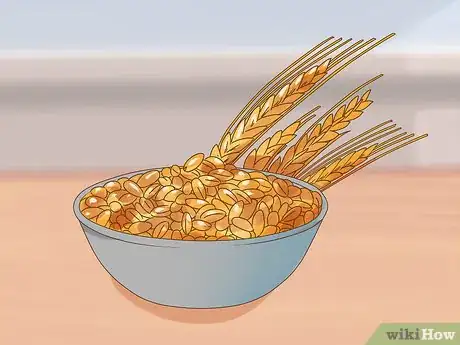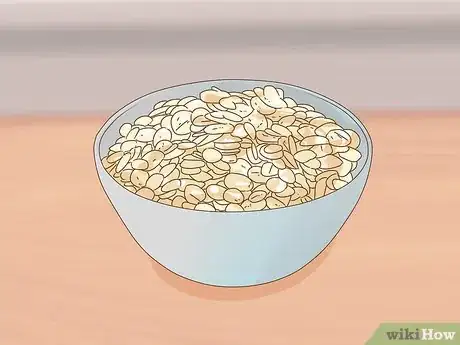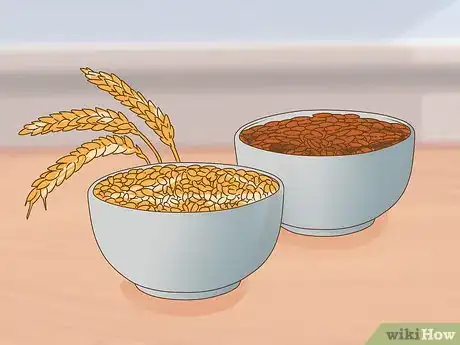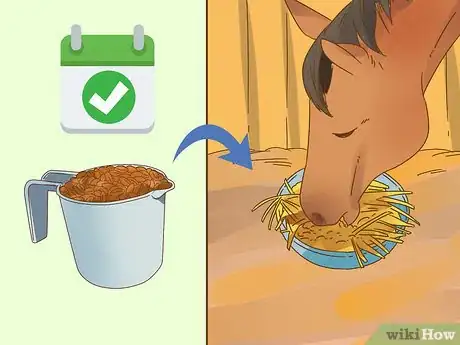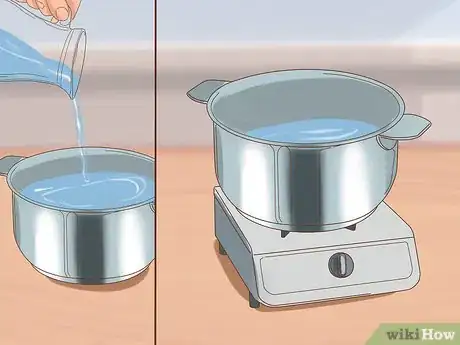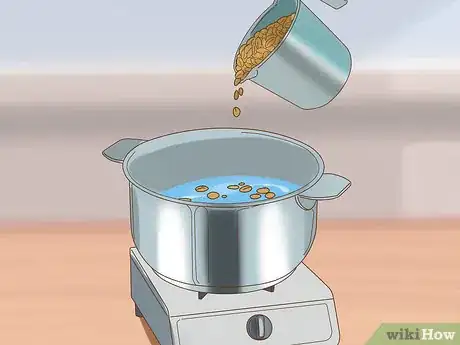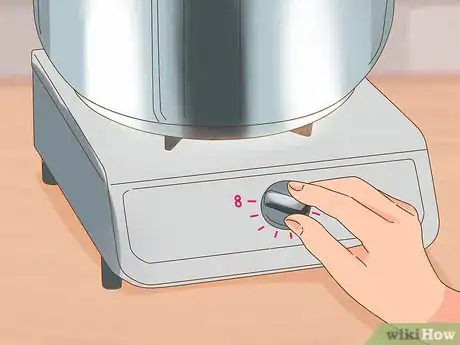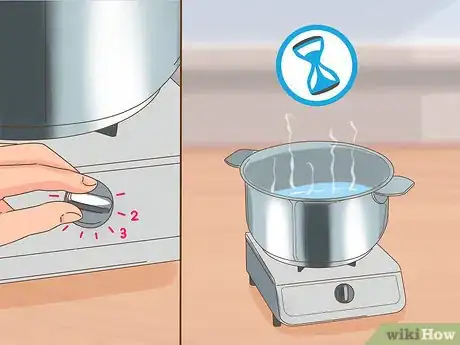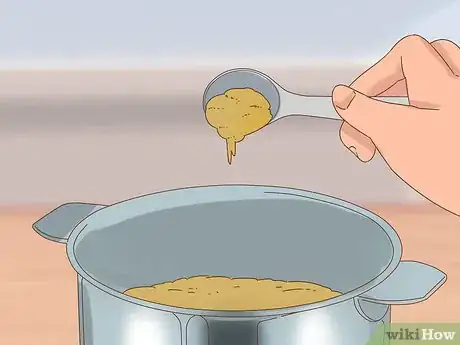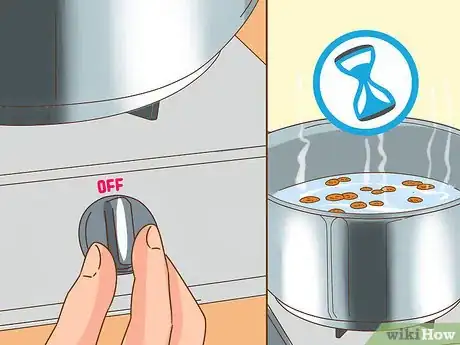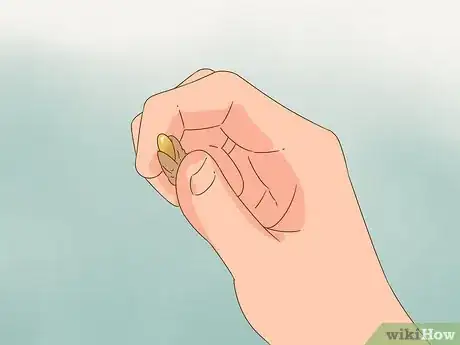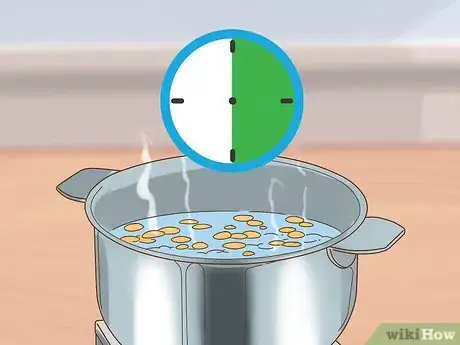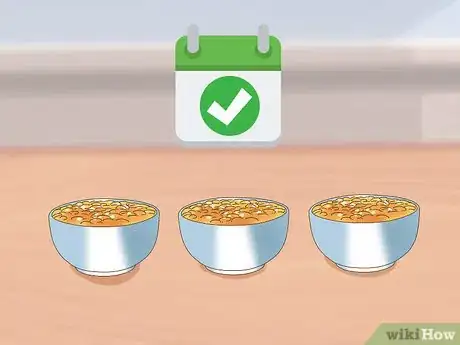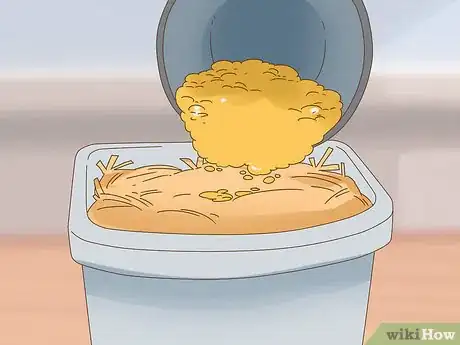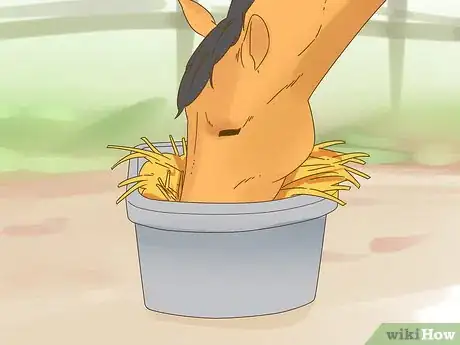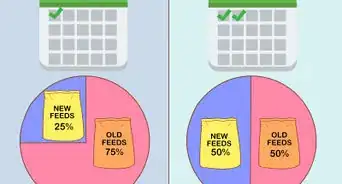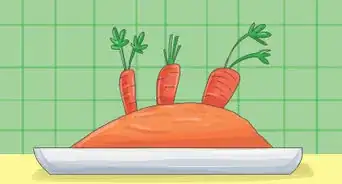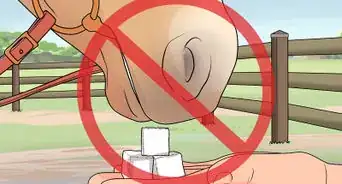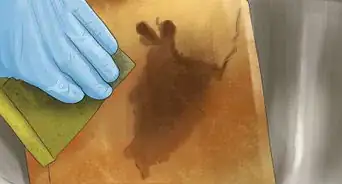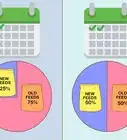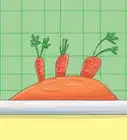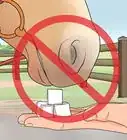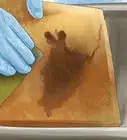This article was co-authored by wikiHow Staff. Our trained team of editors and researchers validate articles for accuracy and comprehensiveness. wikiHow's Content Management Team carefully monitors the work from our editorial staff to ensure that each article is backed by trusted research and meets our high quality standards.
wikiHow marks an article as reader-approved once it receives enough positive feedback. In this case, 100% of readers who voted found the article helpful, earning it our reader-approved status.
This article has been viewed 56,348 times.
Learn more...
Boiled grains are a great way to help your horse stay nourished and put on healthy weight. Not only do they contain natural vitamins and minerals, but they also provide a bulk that's greater than the equivalent dried weight of the same grain. However, if you don't boil them properly they can expand due to moisture absorption in the stomach. Over time, this can give your horse nasty health problems such as colic and founder. Make sure you choose the proper grains, carry out the right steps for heating, and feed your horse the proper amount per day.
Ingredients
- Whole grains
- Boiling water
- Herbs (optional)
Steps
Choosing Your Grains
-
1Use barley for a safe, low-fiber feed. Head to a natural foods store or online supplier to purchase your raw grains. Barley is the safest grain to boil, as oats tend to heat horses up. It's also the more dense food option and is harder than oats.[1]
- Combine barley with oats if you'd like.
- If your horse isn't eating barley, it might not prefer its "heavy" nature." Switch to oats and see if it prefers them.
-
2Choose oats for a high-fiber grain ideal for racehorses. Oats have more bulk for each portion of nutrient content, which means horses have to eat more to get the right amount of nutrients. If you have a racehorse that needs to put on weight, opt to feed it boiled oats.[2]
- Always use oats that are clean, plump, heavy, and bright-colored with no odor.
- Make sure there's a low ratio of husks to kernels.
Advertisement -
3Never feed your horse wheat and avoid using linseed grains. Feeding a horse wheat can cause laminitis and grain poisoning, so never offer this grain. Boiling linseed grains improperly can cause a build-up of acid and toxins, so it's best to avoid this unless you have specific instructions from an equine veterinarian.[3]
-
4Start feeding your horse 1 cup (128 grams) of grains daily. Always begin a new feed product slowly and gradually add them to your horse's standard diet of hay or grass. Start by feeding your horse 1 cup (128 grams) of food per day and take note of how it responds. If it's eating all of the grains every day, start adding more.[4]
- If your horse isn't eating all of the grains every day, switch to a different kind until you find something it likes.
Boiling and Simmering Your Grains
-
1Fill a large 10.5 cup (2.5 L) pot halfway with water and put it on the stove. Always use a large pot, as grains more than double in size when boiled. Fill it with cold water, place the pot on the stovetop, and let it sit.[5]
- Always use cold tap water as hot tap water has a tendency to pick up lead when it travels through water pipes.
- Don't fill your pot all the way with water or it might splash you as it boils.
-
2Add 1 cup (128 grams) of raw grains to the pot of water. Using a measuring cup, scale out the grains and pour them into the pot. Make sure the grains are completely covered with a 1⁄2 inch (1.3 cm) or more of water above the grain.[6]
- Pour the grains gently into the pan to avoid splashing yourself with water.
- Always cook 1 day worth of grains at a time.
-
3Turn the element to high until the water boils. High heat is "8" on most stove dials. Wait until the water comes to a rolling boil, which is when there is steam, bubbles, and constant movement that doesn't stop even when stirring the water.[7]
- Water boils at 212 °F (100 °C).
-
4Reduce the heat to "2" or "3" and simmer your grains for 10 minutes to 1 hour. After the water begins to bubble and boil, reduce the heat on your stove to a medium simmer. Usually, this is accomplished on about setting "2" or "3" from the lowest. Afterward, let your grains simmer for 30 minutes to 1 hour—the exact time depends on the grain.[8]
- Simmer barley for 40 to 50 minutes, oats for 30 minutes, and corn for 10 minutes. The grains should be soft and tender when they're ready to eat.
- To check for simmering, look for small- to medium-sized bubbles that break the surface of the water frequently. This typically happens at 195 to 212 °F (91 to 100 °C).
- Make sure the lid is on the pot to prevent the evaporation of moisture.
-
5Add 1 tbsp (14.3 g) of herbs to the grains as they simmer for additional flavor. Chamomile, which is best used as a tea, is a great addition. Once the grains have cooled, pour the excess juice into a bowl and feed it to your horse to give them the added benefits of both grain and chamomile tea.[9]
- Try adding garlic or any herbs that your horse likes.
-
6Turn the stove top off and let the grains expand for 3 to 4 hours. As the grains gradually cool down, they will absorb the moisture in the pot. You may need to add more water after about 1 hour or so—enough that they stay submerged—to keep them moist so they don't dry out and become hard.[10]
- If you're boiling your grains in the morning, leave them for 3 to 4 hours. If you're boiling them at night, leave them overnight with the heat off. By the morning, the grains will be only slightly warm and you will notice they have expanded much more.
-
7Squeeze the grains after they have expanded to test their softness. After the grains expand, squeeze each one gently and see if their flesh pops out. If it does, the grains are soft enough for your horse to eat. If the grains are still hard, leave them in the water for longer.
-
8Let the grains cool for 30 minutes and then feed them to your horse. Turn off the heat and leave the grains to cool for about 30 minutes or until you can touch them grain with your fingers. Afterward, you can feed them to your horse using a feed bucket.[11]
- Try serving the grains when they are cooled but still warm to make them more appetizing. However, you can feed it cold if you'd like.
Feeding Your Horse
-
1Feed your horse boiled grains in 2 to 3 evenly-spaced servings daily. Split your grains into 2 to 3 portions and add them to your horse's standard feed throughout the day. Remember that horses can have approximately 1⁄2 pound (0.23 kg) of grain for every 100 pounds (45 kg) of body weight.[12]
- Always measure your portions after splitting up your grains.
- During hot weather, feed your grains during the cooler temperatures, such as the morning and evening.
-
2Provide the grains in a horse feed bucket. After boiling your grains, pour each portion into its feed bucket along with its hay and grass.[13]
- Mix your grains with any other treats and supplements that you feed your horse.
-
3Continue feeding your horse hay and grass. These structural carbohydrates are crucial to your horse's diet. As a rule of thumb, feed your horse 1 to 2 percent of their body weight in hay or grass each day.[14]
- Keep your horse feed free of dust and mold.
Community Q&A
-
QuestionHow much should I feed to my 26 year-old Shetland to put some weight on her?
 Community AnswerIt depends, really. Just start giving her more than you usually do. Make sure that it's mostly chaff, though, because you don't want to make her too energetic.
Community AnswerIt depends, really. Just start giving her more than you usually do. Make sure that it's mostly chaff, though, because you don't want to make her too energetic.
Warnings
- When horses are fed large quantities of grain, their teeth become sharp. Although the boiled grains are easier to digest and require less chewing, you should ensure they get dentist work every 12 months and a checkup every 6 to 8 months.⧼thumbs_response⧽
- Worm burdens are usually greater in those horses that eat a lot of processed grains, so regular worming is critical and essential.⧼thumbs_response⧽
- If boiled grain is left for a few days, it can begin to ferment and grow bacteria and mold.⧼thumbs_response⧽
- Only boil enough grain for the day.⧼thumbs_response⧽
- Don't leave the saucepan unattended, as it can boil over.⧼thumbs_response⧽
Things You'll Need
- Large saucepan
- Stove
- Feed bucket
References
- ↑ https://articles.extension.org/pages/10246/grains-for-horses-and-their-characteristics
- ↑ https://articles.extension.org/pages/10246/grains-for-horses-and-their-characteristics
- ↑ https://articles.extension.org/pages/10246/grains-for-horses-and-their-characteristics
- ↑ https://articles.extension.org/pages/10246/grains-for-horses-and-their-characteristics
- ↑ https://practicalhorsemanmag.com/health-archive/flaxseed_101804
- ↑ https://practicalhorsemanmag.com/health-archive/flaxseed_101804
- ↑ https://www.seriouseats.com/2010/08/how-to-boil-water-faster-simmer-temperatures.html
- ↑ https://practicalhorsemanmag.com/health-archive/flaxseed_101804
- ↑ https://practicalhorsemanmag.com/health-archive/flaxseed_101804
